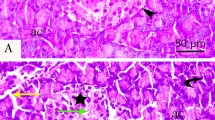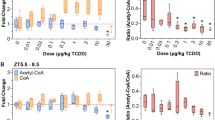Abstract
POLYCHLORINATED biphenyls (PCBs) are widely used industrial chemicals which have found their way into the environment, where they have been detected in rainwater, in many species of birds and fish and in human tissues. PCBs accumulate in the body's fat tissues, where they apparently degrade very slowly under natural conditions1, but recently it has been found2 that PCBs may act as carcinogens. The detailed actions of PCBs inside the body, such as their effects on carbohydrate, lipid or protein metabolism, are relatively unknown although they have been shown to alter the liver cell in mouse and monkey3, to affect the immune system4 and to alter the activity of microsomal and other enzyme systems5–8. We have studied the in vivo effect of PCBs on the activity of two regulatory enzymes of gluconeogenesis, phosphopenol-pyruvate carboxykinase (PEPCK) and fructose-1, 6-diphosphatase (FDPase), respectively, in rat liver.
This is a preview of subscription content, access via your institution
Access options
Subscribe to this journal
Receive 51 print issues and online access
$199.00 per year
only $3.90 per issue
Buy this article
- Purchase on Springer Link
- Instant access to full article PDF
Prices may be subject to local taxes which are calculated during checkout
Similar content being viewed by others
References
Hammond, A. L., Science, 175, 155–156 (1972).
Kimbrough, R., New Scient., 68, 331–336 (1975).
Nishizumi, M., Archs Environ. Hlth, 21, 620–632 (1970).
Vos, J. G., and De Roij, Th., Tox. appl. Pharmac., 21, 549–555 (1972).
Litterst, C. L., Farber, T. M., Baker, A. M., and van Loon, E. J., Tox. appl. Pharmac., 23, 112–122 (1972).
Villeneuve, D. C., Grant, D. L., Phillips, W. E. J., Clark, M. L., and Clegg, D. J., Bull. environ. Contam. Tox., 6, 120–128 (1971).
Alvares, A. P., Bichers, D. R., and Kappas, A., Proc. natn. Acad. Sci. U.S.A., 70, 1321–1325 (1973).
Davis, P. W., Friedhoff, J. M., and Wedemeyer, G. A., Bull. environ. Contam. Tox., 8, 69–72 (1972).
Lardy, H. A., Foster, D. O., Shrago, E., and Ray, P. D., Adv. Enzyme Reg., 2, 39–47 (1964).
Krone, W., Huttner, W. B., Seitz, H. J., and Tarnowski, W., FEBS Lett., 52, 85–89 (1975).
Seubert, W., and Huth, W., Biochem. Z., 343, 176–191 (1965).
Racker, E., Meth. Enzymol., 5, 272–273 (1962).
Bergmeyer, H. U., and Bernt, E., in Methoden der enzymat. Analyse, 3rd ed. (edit. by Bergmeyer, H. U.), 1250–1258 (Verlag Chemie, 1974).
Author information
Authors and Affiliations
Rights and permissions
About this article
Cite this article
MESSNER, B., BERNDT, J. & STILL, J. Inhibition of PEP-carboxykinase in rat liver by polychlorinated biphenyl. Nature 263, 599–600 (1976). https://doi.org/10.1038/263599a0
Received:
Accepted:
Issue Date:
DOI: https://doi.org/10.1038/263599a0
This article is cited by
-
Predominant periportal expression of the fructose 1,6-bisphosphatase gene in rat liver: dynamics during the daily feeding rhythm and starvation-refeeding cycle
Histochemistry and Cell Biology (1995)
-
Comparative toxicity of four chlorinated dibenzo-p-dioxins (CDDs) and their mixture
Archives of Toxicology (1992)
Comments
By submitting a comment you agree to abide by our Terms and Community Guidelines. If you find something abusive or that does not comply with our terms or guidelines please flag it as inappropriate.



